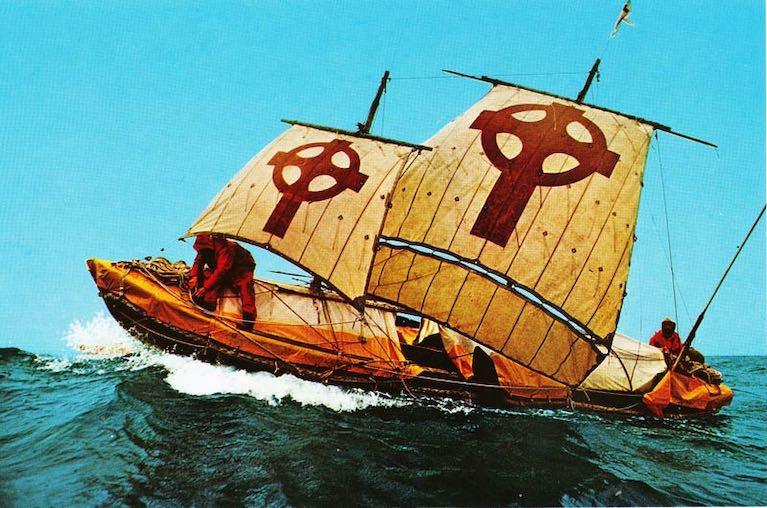When the Courtmacsherry Harbour Boat Club was founded ten years ago, the late Tim Severin - the neighbourhood's own legendary sea adventurer and explorer of international renown - found himself in several roles at the inaugural gathering. Naturally, he was listed as a Founding Member. But he was an Honorary Member too. He was also Guest of Honour. And he was the CHBC inaugural speaker as well.
Severin – who died at home near Courtmacsherry on December 18th age 80 – had in his time given very high-powered talks to organisations of the calibre of the Royal Geographical Society in London and the National Geographic Society in the US on such topics as his "voyaging archaeology" re-enactments of classical mythology such as Jason and the Argonauts, and Sindbad to the Far East.
But in Courtmac on that first meeting of the little club a decade ago - as fellow CHBC founder member Norman Kean of the Irish Cruising Club Sailing Directions recalls it - all they were interested in hearing about was his 1976-77 breakthrough re-creation of the supposedly-mythical voyaging of St Brendan the Navigator in an oversize traditionally-built currach, sailing from Ireland to the Scottish Hebrides, the Faroes, Iceland, Greenland and eventually to North America at Newfoundland.
At the time in the late 1970s, it made a remarkable impact. It showed that the kind of boat technology which would have been available to Brendan the Navigator when he was supposedly making his extraordinary voyages around 512-530 AD could have provided a boat capable of crossing the North Atlantic east to west.
 His own man, and something of an enigma with it – Tim Severin at home in his beloved West Cork
His own man, and something of an enigma with it – Tim Severin at home in his beloved West Cork
But at that very special little Courtmacsherry meeting in 2010, Tim Severin made a remarkable admission. He said that it was lucky that the Brendan voyage was his first major ocean-going project.
For if he'd contemplated undertaking it after gaining the seafaring experience of the Jason voyage and the Sindbad expedition, he would have reckoned that a cold water voyage with ice risk in a 36ft slip of a boat whose oxhide skin could be sliced by the smallest ice floe was impossibly dangerous, and he'd have turned his attention elsewhere.
Yet in contemplating the lifepath of Tim Severin, the Brendan voyage was a seminal event which simply had to be achieved before anything else could fall properly into place. Though quite where that place might be could be vague enough. For although he seemed quintessentially English living quietly around Courtmacsherry and Timoleague, he had an Irish passport and citizenship for at least the final thirty years of his long life. Yet he was the fourth generation of his family to be born in India where his father was a tea planter, while in one interpretation, the name Severin has distinct Balkan connections.
Be that as it may, as a "colonial brat" he excelled so much at school in England that he was able to take a gap year travelling with much enjoyment across the US before taking up a place at Oxford where, in one of the long vacations, he teamed up with a couple of fellow students – one of them Stanley Johnson, father of Boris – to re-trace on motor-bikes the route of Marco Polo to China.
Under-pinning the scheme was a project whereby a friend would write a book about it all. But his efforts being rejected by the publisher, somehow Severin himself ended up becoming the author, and with the publication of Tracking Marco Polo in 1964 – possibly his most straightforwardly entertaining book, but then none of his other ventures involved Stanley Johnson - the first seeds of Severin's career were planted.
 Courtmacsherry in high summer. On such a day in 1970, Tim Severin stopped by for a pint – and stayed
Courtmacsherry in high summer. On such a day in 1970, Tim Severin stopped by for a pint – and stayed
Yet it didn't go completely smoothly at first either professionally or privately, and around 1970 he arrived in West Cork seeking escape and a cheap place to live. Some say he was travelling in an ancient Volkswagen Beetle, others say he was back-packing and hitching. But either way, on one of those days of high summer when West Cork slumbers as only West Cork can, he wandered into the pub in Courtmacsherry where two or three afternoon pint men were escaping the glare of the sun, and felt his cares slip away.
He was a man of few words, reticent and reserved rather than shy, but it wasn't long before he found himself asking how you might rent or even buy a house in this place.
Three voices responded as one: "Which house might you be thinking of buying?" Within minutes, Tim Severin was on his way to being a resident of the Courtmacsherry area, with his only change of address in the years ahead being an eventual move a few miles up the road to Inchy Bridge close inland of Timoleague, where he and his wife created their ideal homeplace while prudently supporting it with a little complex of holiday cottages which were always there to provide income if his latest in a series of remarkable expeditions failed to meet its financial targets.
This was always a possibility because Tim Severin was very far indeed from being a successful showman-explorer in the contemporary 24/7 communications style. If a camera was being used, he much preferred to be behind it rather than on screen. So for someone who so cherished his personal privacy, he was maybe in the wrong line of business altogether.
For although his commitment to life in West Cork was such that he readily agreed to open maritime art shows and talk to the Glandore Classic Boat Summer School and speak at the inaugural meeting of the Courtmacsherry Harbour Boat Club, it was the silent solitary technical challenges of these mythological re-enactments which most interested him, rather than publicly performing after they'd been completed.
It was some time after he'd settled in Courtmacsherry that the notion of the Brendan voyage began to develop, and he planned each step with much thought. Logically, if you wanted to build a large currach, then first choice would surely be to seek out a traditional builder in the currach heartlands in north Kerry at the Maharees, or further north in Connemara.
But he'd put that noted boat designer Colin Mudie (he did the design for the re-creation of the Dunbrody at New Ross) to work on the project in drawing the lines, and as they wanted to be totally traditional in using greased oxhide rather than the tarred canvas universally used in both Kerry and Connemara, they reckoned that what was needed was space in an established boatyard where they could experiment without getting bewildering input from many experts. And thus did Tim Severin find his way to the overall boss of Crosshaven Boatyard, the one and only Denis Doyle.
 "Just follow your nose" – the building of the Brendan currach in Crosshaven Boatyard offered a very special olfactory experience
"Just follow your nose" – the building of the Brendan currach in Crosshaven Boatyard offered a very special olfactory experience
Crosshaven Boatyard was of course only one of The Doyler's many business interests, but as he'd already built Francis Chichester's much-liked Gipsy Moth V there in 1970, he'd a taste for something special and unusual. He and Tim Severin had dinner together to assess each other and discuss the possibility of a yard accustomed to wood building to the highest international standards taking on the construction of an oxhide traditional boat using almost prehistoric technology, and those two very different men got on so well that within weeks construction was under way in Crosshaven.
For six months a supposedly semi-secret section of the yard stank to high heaven with the smell of oxhide and other ancient and extremely organic substances. Thus it was the most enormous relief to all involved when the Brendan currach was launched, and they could see about restoring that much-loved traditional wooden boatyard aroma.
 Brendan launching at Crosshaven in 1976. In a remarkable historic conjunction, the Strand Farmhouse beyond on the shore in Currabinny had only recently become Ron Holland's first proper design studio
Brendan launching at Crosshaven in 1976. In a remarkable historic conjunction, the Strand Farmhouse beyond on the shore in Currabinny had only recently become Ron Holland's first proper design studio
Meanwhile, the Brendan juggernaut was gathering pace with sponsorship from the National Geographic and – curiously enough – The Reader's Digest, such that for someone of Tim Severin's retiring nature, it must have been a monumental effort of self-control to endure the huge circus around the seemingly fragile boat's departure, which was from Brandan Creek immediately west of Mount Brandon on the north coast of the Dingle Peninsula.
 The Brendan currach free at last, at sea off Brandon Creek at the start of the voyage.
The Brendan currach free at last, at sea off Brandon Creek at the start of the voyage.
But once on their way, he became himself. Observing Irish crewman Wallace Clark – who was aboard for the section to the Hebrides – finding frustration in a period of very slow progress, he smiled gently and quietly remarked: "We all now have to think ourselves back into a pre-mediaeval frame of mind. We may have an objective. But we don't have a schedule - in fact, we've no concept of a schedule."
Thanks to the gradual prevalence of this mindset, the Brendan voyage was eventually successfully completed, albeit with some experiences of real life-and-death hazards. The theory was proven, and the fame was established such that though The Brendan Voyage was Tim Severin's seventh book - and there were to be many others that followed it – increasingly it is this one achievement which defines him.
 Tim Severin in 2016 with the Brendan in Craggaunowen Heritage Centre, Kilmurry, Co Clare.
Tim Severin in 2016 with the Brendan in Craggaunowen Heritage Centre, Kilmurry, Co Clare.
And while Tim Severin may have gone from among us, both the currach and the words and music she inspired live on. The Brendan currach is preserved at Craggaunowen in County Clare, while three years after the voyage was completed, the sublime orchestral music of The Brendan Voyage was recorded for the first time in 1980.
Written by Shaun Davey - whose childhood summers had been spent in and around boats at Cultra on Belfast Lough - it was the first time the traditional uilleann pipes had been blended with an orchestra, with the pipes played by the late Liam O'Flynn in a convincing style which made them the little boat, while the orchestra became all the elements in which she sailed.
Part of The Brendan Voyage by Shaun Davey
Today, it's more popular than ever. As for the man who filled the key role in its inspiration, Tim Severin continued writing to the end, his final works being historical novels which explored the relationship between Ireland and the Vikings, and of Spanish-Irish seafarers in a continuation of his special relationship with his adopted home. Ireland was good for Tim Severin, and Tim Severin was very good for Ireland. His was a long and fulfilled life which touched the lives of many people, and our thoughts are with his family and friends.
WMN































































